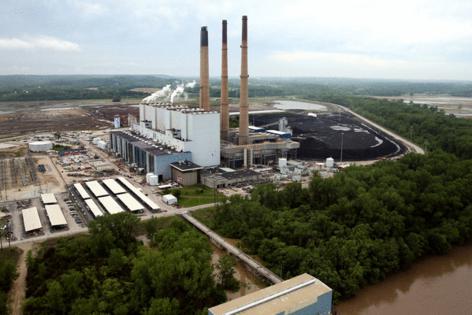Ameren coal plant is top polluter. Labadie emits more SO2 than any in US
Published in Business News
ST. LOUIS — The region's largest coal plant, the Labadie (Missouri) Energy Center, last year emitted far more of a major air pollutant than any plant in the country, a Post-Dispatch analysis has found.
Companywide, the St. Louis-based electric utility Ameren, which owns Labadie, produced more of the pollutant sulfur dioxide than all but one other U.S. utility, according to the analysis of Environmental Protection Agency data.
And while local experts were unaware of research on impacts of so much sulfur dioxide around St. Louis, at least one national study, published in November, links coal plant pollution to thousands of deaths each year.
"It's very disheartening," said Jay Turner, a professor of engineering at Washington University who focuses on air pollution issues. "That just shows how much coal they're burning."
Indeed, critics say the data highlight two key points: First, that Ameren still produces more than half its power from coal-burning plants, and should hurry efforts to use cleaner energy sources. And, second, that the company's largest plants, such as Labadie, in Franklin County, aren't fitted with pollution controls called "scrubbers" that are now common across the country.
The issue has stoked years of concerns among environmentalists and watchdogs. But it has become more public in recent years, as the company fought in court against regulators aiming to force Ameren to curb emissions at its second-largest plant, the Rush Island Energy Center, 50 miles south of St. Louis along the Mississippi River.
"I want to keep hollering for the right thing to happen," says Steve Mahfood, a former director of the Missouri Department of Natural Resources. "This is at the top of my list for the St. Louis area — doing something about these plants and their emissions."
Ameren said in an emailed statement that at Labadie, it has "done extensive analysis, over many years, and found that there are other ways and technology for Ameren Missouri to meet and exceed environmental requirements and to do so at a cost to customers that is far below that of installing and operating scrubbers."
The company declined multiple requests for an interview on the subject.
Critics say a tangled combination of rules and regulations have allowed Ameren to avoid installing scrubbers, estimated to cost more than $800 million to put on plants like Rush Island.
They say the air monitors at Labadie, for instance, aren't in the right places to reliably detect the main plume of emissions from the plant. They also point to the difficulties of environmental enforcement, particularly at half-century-old coal plants that can be exempted from Clean Air Act laws.
"It's just so absolutely absurd that it's beyond belief," said Mahfood. "I was unhappy about it 20 years ago and I'm still unhappy with it."
They also argue the sulfur dioxide emissions are only part of the problem:
Labadie, based in Franklin County, is also the second-largest producer of greenhouse gases among the nation's coal plants, according to the EPA data.
4,000 excess deaths
Sulfur dioxide, or SO2, which helps harmful particulate matter form in the air, causes or exacerbates a wide range of health problems, including asthma.
And it can affect a sprawling geographic footprint, as fine particle pollution resulting from SO2 emissions "can blow hundreds of miles away," according to the American Lung Association.
St. Louis-area researchers who study sulfur dioxide and its impacts had not studied the downwind effects of the pollutant from the region's coal plants, and they didn't know anyone here who had.
Some national studies, however, have examined the health impacts from U.S. coal plants.
And one of those included Labadie in its research. That study, published in the journal Science in November, uses Medicare records to estimate the number of deaths tied to air pollution from coal plants.
The results: A total of 460,000 excess deaths from 1999 to 2020 were linked to "fine particulate matter" from coal plants.
Labadie, the researchers found, was associated with about 4,000 excess deaths — more, by far, than any other coal plant across seven Midwestern states.
But a vast majority of U.S. coal plants now have scrubbers that eliminate sulfur from emissions before they exit through the smokestacks. One method, for example, sends the gas through a fine mist of water and crushed limestone that reacts with the sulfur, causing it to form gypsum that gets collected, instead of staying in a gaseous state with the rest of the plant's airborne emissions.
The technology does not come cheap, with costs that can reach hundreds of millions of dollars at a single coal plant.
Even so, a rising portion of the nation's coal plants now have them, either because the plants are newer, or because they had to comply with air quality standards to continue operating — or because older plants have simply closed.
Of the 210 coal plants across the U.S., only 25 — or 12% — lack scrubbers, according to the latest EPA data. Ten others have scrubbers on some of their units but not all.
That makes Ameren's plants like Labadie and Rush Island stand out more and more from the rest of the U.S. coal fleet.
Companywide, Ameren, the second-biggest emitter of SO2 across all companies that own a U.S. coal plant, just barely trails Vistra, a far bigger Texas-based utility that has about double Ameren's annual revenues and twice as much power generation from coal.
The bulk of Ameren's SO2 emissions come from Labadie, which emits about 40% more than the nation's next closest plant, according to EPA data. Even if Labadie's SO2 emissions were cut in half, it would still emit more than every U.S. coal plant except two.
Missouri as a whole has six coal plants without scrubbers, more than any other state. And five of those are totally devoid of the pollution controls. Other major Missouri coal plants, such as the Thomas Hill Energy Center, north of Columbia, Missouri, and the New Madrid Power Plant, on the Kentucky border, also rank among the top 15 in the nation for SO2 emissions, although they each emit less than a third of Labadie's total.
39,245 tons of sulfur dioxide
The EPA requires scrubbers on new plants. Significant upgrades to old plants can trigger the requirement. Air monitoring can also reveal that clean air standards are not being met, prompting a need to install scrubbers.
At Rush Island, Ameren made major modifications to the plant's generators in 2007 and 2010 without obtaining permits. The more than $70 million upgrades boosted the 1970s-era plant's power generation as well as emissions, right around the time its machinery was reaching the end of its intended lifespan.
In 2011, the EPA sued Ameren, alleging violations of the Clean Air Act.
In 2017, U.S. District Judge Rodney Sippel agreed, and, two years later, ordered a remedy that called for the company to equip Rush Island with scrubbers.
Ameren instead proposed closing the plant ahead of its 2039 schedule — now set for this year.
But, to counteract Rush Island's excess emissions, Sippel also called for Ameren to install pollution controls at Labadie, a condition later scrapped by a federal appeals court, because "the government never provided notice of or alleged" that the plant committed a Clean Air Act violation.
But Labadie — along with Ameren's other coal plants — did receive notice of Clean Air Act violations from the EPA in at least 2010 and 2011, when Labadie, too, was cited for "major modifications that caused a significant net emissions increase" without first obtaining proper permits.
The EPA only filed suit regarding Rush Island. The agency did not on Friday clarify why.
In 2023, Labadie accounted for 39,245 tons of sulfur dioxide based on EPA data that uses readings taken from inside the exhaust stacks of coal plants.
But the EPA uses a different measure — the air monitors — to gauge public health impacts, which could trigger scrubber requirements.
'The economics of the situation'
The EPA's current standard for SO2 pollution was established in 2010, at 75 parts per billion, a threshold set to protect public health "with an adequate margin of safety, including the health of at-risk populations with asthma," according to the agency.
Around Labadie, ambient SO2 readings seldom reach half of that amount — occasionally peaking at 38 or 44 parts per billion, for instance — based on readings from air monitors placed at locations selected by Ameren.
But critics have long complained that air monitoring around the Labadie plant is insufficient: Four monitors are placed in areas they say are unlikely to accurately register pollution from the facility. Prevailing westerly winds generally push air pollution to the east. But only one of Labadie's stations is east of the plant.
"If your monitors are not in the proper spots, it's going to show, 'Hey, everything is OK,'" said Mahfood, the former Department of Natural Resources director.
But both state and EPA regulators say that the dispersal of Labadie's emissions is influenced by different forces — from weather conditions to local topography — and that computer modeling says the current monitors around the plant would indeed pick up persistent air quality violations.
The monitor locations "really do a good job in characterizing impact from that facility," said Stephen Hall, the director of MDNR's Air Pollution Control Program. He added that "citizens can be confident" that air quality standards are being met in the area.
Mahfood says he struggles to envision major change — let alone scrubbers — coming to Labadie anytime soon.
Ultimately, he expects economic trends could be the eventual impetus for change, by making it imprudent for Ameren to keep it running, as financial woes mount for coal power and costs plunge for alternative power sources — a combination that has helped shutter coal plants from coast to coast.
"It's the economics of the situation that will probably get Ameren to move," said Mahfood. "The plant needs to go."
©2024 STLtoday.com. Distributed by Tribune Content Agency, LLC.







Comments